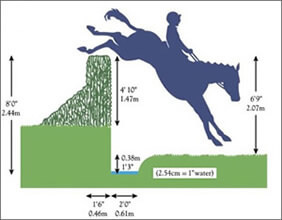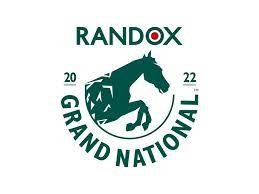Which fences are jumped just once during the Grand National?
 The Grand National is run over two full circuits of a flat, triangular course, 2 miles 2 furlongs in extent. Often described as the ‘ultimate test of horse and rider’, the Grand National takes in a total of 30 distinctive, spruce-covered fences, 16 of which are jumped on the first circuit and 14 on the second.
The Grand National is run over two full circuits of a flat, triangular course, 2 miles 2 furlongs in extent. Often described as the ‘ultimate test of horse and rider’, the Grand National takes in a total of 30 distinctive, spruce-covered fences, 16 of which are jumped on the first circuit and 14 on the second.
The fences that are jumped just once during the Grand National are the final two on the first circuit, namely The Chair and the Water Jump. Standing 5’2″ high and preceded by 6′ wide ditch on the take-off side, The Chair is both the tallest and broadest obstacle on the Grand National course. The ground on the landing side is actually 6″ higher than that on the take-off side, making The Chair a formidable obstacle, especially for inexperienced horses.
By contrast, the Water Jump stands just 2’9″ high, but features an expanse of water, 8’10” wide and 6″ deep, on the landing side. Thus, from the point of take-off, horses must cover a total horizontal distance of 14’4″ to clear the fence and the water beyond. Positioned as it is, right in front of the grandstands, the Water Jump provides a thrilling spectacle for viewers. On the second circuit of the Grand National, having jumped the thirtieth and final fence, runners tack right, bypassing The Chair and the Water Jump, and set off up the infamously long, 494-yard run-in to the winning post.
 The standard each-way terms on any horse race are dictated by the number of runners and, once that number rises to twelve or more, by whether or not the race is a handicap. The Grand National is, of course, a handicap, in which a maximum of 40 runners are permitted to participate. Thus, if bookmakers apply the strict letter of the law, the standard each-way terms are the same as any other handicap with 16 or more runners; first, second, third and fourth place are paid, at one quarter of the win odds.
The standard each-way terms on any horse race are dictated by the number of runners and, once that number rises to twelve or more, by whether or not the race is a handicap. The Grand National is, of course, a handicap, in which a maximum of 40 runners are permitted to participate. Thus, if bookmakers apply the strict letter of the law, the standard each-way terms are the same as any other handicap with 16 or more runners; first, second, third and fourth place are paid, at one quarter of the win odds.